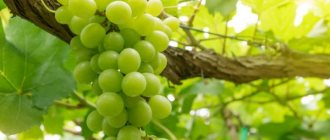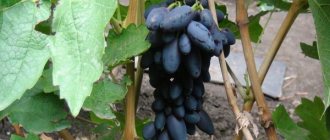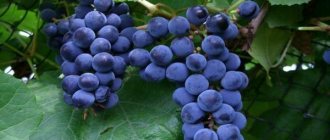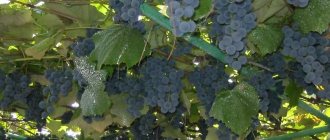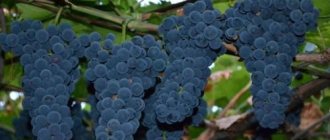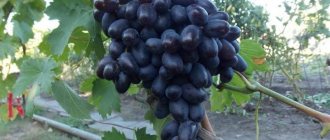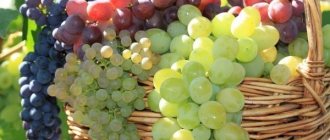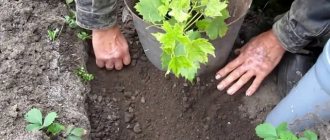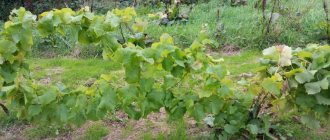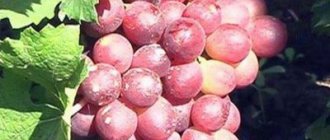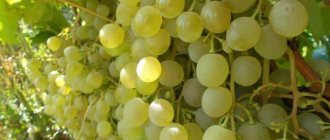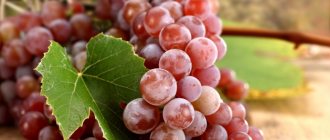Description of grapes Original
The shape of the fruit is elongated, on average reaching 3 cm in length and 2 cm in diameter. The grape has a point at the bottom. Ripe representatives of the variety weigh about 5-7 g, but it is possible that units may appear that reach a weight of 10-12 g.
The bunch looks like a cone on which the berries are located relatively densely. The weight of each bunch is from 600 to 2,000 g. The variety has three colors, of which black is considered the lightest. Average in all respects - pink grape variety Original.
Important! White grapes are considered the most sour.
Description of the taste of the Original grape variety depends on the amount of sugar and acidity level. The acidity level of the white Original is 8 g/l, while the other representatives of the variety are 6 g/l. The amount of sugar in fruits varies from 15 to 21%; this parameter is directly affected by growing conditions.
The aroma from the Original is not strong, the flesh is juicy. If the grapes are not picked from the bushes in time, this will lead to changes in the berries for the worse (they will become watery). The variety is not distinguished by a large number of seeds; as a rule, there are no more than 2 of them in each unit. The skin covering the pulp is thin and almost invisible when bitten.
Grapes can be stored until January. Problems with the Original variety arise only at the transportation stage. During transportation, large berries are torn from the stalk.
To better imagine the appearance of the Original grapes, you should familiarize yourself with the photo.
The Original bush is distinguished by its height (up to three meters) and splendor. The leaves are dissected and consist of five lobes with drooping lobes.
The Original grape growing region is wide due to its ability to tolerate frosts down to -210. The variety can be found in southern and middle latitudes.
Comparison with analogues
Let's compare the “original” with some other varieties.
| Sign | Variety | |||
| Original | Rumba | Sofia | Libya | |
| Ripening period | 120-130 days | 110-115 days | 100-115 days | 105-110 days |
| Frost resistance | Up to -24 °C | Up to -24 °C | Up to -21 °C | up to -21°С |
| Yield per bush | up to 100 kg | 50-60 kg | 50-70 kg | up to 30 kg |
| Bunches | 500-800 g | From 800 g to 1.2 kg | 800-1200 g | 0.8-1.2 kg |
| Taste | Harmonious | With notes of cherry | With a nutmeg aftertaste | nutmeg aroma |
| Color | Green-yellow | Amber pink | Light pink | pink |
| Disease resistance | Average | High | Average | average |
| Shelf life | Few weeks | Up to 6 months | 3-5 weeks | up to 1 month |
| Sugar content | 15-21% | 18-20% | 20% | 18-23% |
| Acidity | 6-8 g/l | 5-7 g/l | Not installed | 6-7 g/l |
Characteristics of the variety
Drought resistance, frost resistance
Grapes tolerate frost only if a high-quality shelter is created. It does not like heavy rainfall, as this leads to loss of taste (sugar does not have time to fill the fruit, and the Original acquires a neutral taste without sweetness).
Productivity and fruiting
The ripening period of the Original is 135-145 days. Harvesting can be done in late August - early September. Yield coefficient from 1.1 to 1.7. A summer resident can collect from 40 to 100 kg of berries from one bush. Black grapes of the Original variety taste sweet and soft. White fruits are more sour. The variety can fall off only after full ripening; until this moment the fruit is firmly held on the branch. The original does not bake in the sun. Productivity and taste may decline due to lack of sunlight or excess water.
Area of application of fruits
The original is not used in industrial enterprises to produce wine. But due to the sufficient amount of sugar in the composition, this is quite possible at home. The grapes can be stored until January. Problems can only arise during transportation: fresh fruits fall off the branch.
Resistance to diseases and pests
The original has excellent resistance to rot, oidium and phylloxera. Almost no diseases infect grape bushes. Rarely, a variety can be affected by mildew.
Important! The frequency of pest damage to grapes directly depends on the color of the variety.
The main danger of the Original is wasps, which easily reach the sweet pulp through the thin peel. The frequency of wasp damage to grapes directly depends on the color of the fruit.
| Variety color | Frequency of lesion |
| Black | High |
| Pink | Average |
| White | Low |
Black grapes Original are quite popular, despite the high possibility of disease. This is due to the taste of the berries due to the amount of sugar contained in the variety.
Advantages and disadvantages of the variety
The original is a variety that is distinguished by its set of positive qualities. Among the advantages, the following characteristics can be noted:
- large volume of fruiting;
- appearance of the bush and fruits;
- the bush quickly acquires greenery after planting the seedling;
- the fruits have a long shelf life.
Photo of ripe pink grapes Original:
But there are also disadvantages in grapes. Among them:
- ripe berries fall off the bunch;
- low resistance to freezing;
- with improper care or bad weather, the berries grow small;
- the variety is affected by the felt mite;
- Berries on the shoots ripen more slowly.
Origin
“Original” is a table grape variety, bred in 1970 as a result of breeding work by scientists from the Odessa Research Institute of Viticulture named after. V. E. Tairova. The variety was included in the State Register in 2009.
Parents of the “pink original” are “damask rose” and “datier de saint-valier”
The parent plants were the Damask rose variety, which gave the “original” the taste and shape of the berries, and Datier de Saint-Valier, from which the new variety took its resistance to diseases and frost.
Varieties
But there are already three different “originals”. In essence, these are the same grapes, with minimal differences in taste and shape, but with different colors of the berries. Let's take a closer look at the varieties of the “original” in the table:
| Signs | Black Original | White Original | Pink Original |
| Ripening period | Mid-late 130-140 | Mid-late 140-150 | Mid-late 135-145 |
| Frost resistance | up to -25C | up to -25C | up to -27C |
| Bunches | 500-750 gr. | 500-700 gr. | 800-1000 gr. |
| Berry | 7-9 gr. | 6-8 gr. | 7-9 gr. |
| Taste | Sugar content: 14-15% Acidity: 7-9 g/l | Sugar content: 14-15% Acidity: 7-9 g/l | Sugar content: 18-20% Acidity: 5-6g/l |
| Disease resistance | High | High | High |
| Bush | Strong-haired | Strong-haired | Strong-haired |
| Shelf life | Long | Long | Long |
“Black original”, “white original” and “pink original” respectively
Rules for planting grapes
Recommended timing
Planting of seedlings should occur in spring or autumn. In the first case - until the moment of sap flow, and in the second - before the start of the frost season. The choice of season depends on the desires of the gardener himself. When planting in autumn, there is a large selection of cuttings on the market, which allows you to choose the most beautiful and healthy specimens. And when planted in the spring, the Original takes root better and strengthens before winter frosts.
Choosing a suitable location
The variety is not fussy when planted, but in the process it is necessary to take into account some nuances regarding the choice of a suitable place for the grapes. Therefore, the description of the place for black grapes by the Original has only general points.
The variety should be located south or southwest of the building on the site. This allows you to protect the Original from strong winds. Other shrubs and small trees can perform a similar function. It is also important to ensure that you receive enough sunlight. The heat received by the plant will directly affect the taste of the berries.
Selection and preparation of planting material
Grapes can be planted in any soil, but fertile and light soil is considered favorable. If sand and clay predominate on the site, then the soil will have to be fertilized for three years before planting the variety. For this, humus or compost is used; modified mixtures from stores are not required.
It is important to monitor the groundwater level. If the depth is less than 1.5 m, this will negatively affect the fertility of the Original. Groundwater can damage the root system.
Landing algorithm
Landing occurs in accordance with the following action plan:
- A suitable location is selected.
- A hole is dug with the following characteristics: diameter - 30-40 cm, depth - 30 cm.
- The excavated soil should be mixed with humus and sand (2 to 1 to 1).
- The roots of the seedling are soaked in a growth stimulator to strengthen the root system.
- A mixture of earth, humus and sand is placed down the prepared pit in the form of a mound.
- A seedling is placed on the resulting mound.
- The hole is half filled, the earth is compacted and watered.
- To support the vine, you need to stick a peg.
- The remaining soil is filled in. In this case, the seedling should be covered by 6 cm.
Features of cultivation
It is necessary to place seedlings in sunny areas where there are no through winds. The soil for growing should be nutritious and light. Soil moisture should be moderate; groundwater height less than 1.5 m is unacceptable.
Important! When deciding to place several bushes on the site at once, you should remember. That the distance between them should not be less than 2 m.
The cuttings, like the “Original” seedlings, take root well and actively grow greenery. As the plant grows, it should be pruned, forming a neat fruit-bearing bush. When forming a vine, it is recommended to prune mature shoots into 8-12 buds. The total load on the bush should not exceed 60 buds.
The variety does not require any special fertilizers. For feeding, you can use peat, rotted manure, compost or ash. It is worth noting that young grape bushes are more demanding of fertilizer than mature vineyards. Some other secrets of growing “Original” can be learned from the video:
Aftercare for grapes
The original does not require a large amount of water; one bush needs 10 liters per week.
Grapes should be fertilized several times a season. In order for nutrients to reach the roots of the Original in full quantities, it is necessary to prepare a ditch at a distance of 50 cm from the trunk. Depth - no more than half a meter.
During the growing season, four types of feeding are carried out:
- the first - before sending the seedling under winter shelter (composition for each bush: 10 liters of water, 20 g of superphosphate, 10 g of ammonium nitrate and 5 g of potassium salt);
- The second fertilizing is carried out with a similar composition before flowering begins;
- third - when the grapes begin to bear fruit, but potassium salt is excluded from the composition;
- When the berries are collected, fertilizing is carried out with the original composition.
The soil should be loose, so you need to constantly weed the area.
Grape pruning
It is advisable to prune the Original in the first year. At the end of June, the formation of shoots ends; at this point, about 3-4 shoots will grow. But only one of them needs to be left to transmit the entire growth and development of the seedling.
Protecting crops from birds and insects
There are several ways to protect the Original from wasps and other insects and birds:
- cans of beer;
- gauze bags and smoke;
- repellers (ultrasound, laundry soap and aerosols);
- grape net;
- destruction of nests.
Some of the methods are a last resort (destruction of nests), others are completely safe for living creatures (netting or bait with beer). When choosing aerosols and mixtures, you need to make sure that the mixture will not cause irreparable damage to the grapes themselves.
Preparing the crop for winter
Winter is the period when grapes can die. Therefore, it is necessary to carry out preparatory work in early August:
- In the morning, a hole is dug around the bush, the depth of which should be about 20 cm.
- All roots must be removed as close to the shoot as possible, the procedure is carried out carefully so as not to damage the system itself.
- The hole is filled with earth.
Special
6.1 Old grape varieties 6.2 New grape varieties 6.3 Photos of grapes
Developed in 1947 at VNIIViV named after. Ya. I. Potapenko as a result of crossing the varieties Madeleine Angevin and Karaburnu. One of the earliest varieties, it requires active temperatures of 2050–2100 °C to ripen the berries.
The leaf is medium-sized, rounded, five-lobed, deeply dissected. The upper notches are deep, closed, with an oval, ovoid lumen. The lower notches of medium depth are open, lyre-shaped. The petiole notch is closed, with an elliptical lumen or open, lyre-shaped or vaulted. The teeth at the ends of the blades are triangular and sharp. The teeth along the edge are triangular-saw-toothed, usually with convex sides, sharp. There is no pubescence on the lower surface of the leaf.
The flower is bisexual. The bunch is medium and large, conical, of medium density. The average weight of a bunch is 158.3 g, the largest is 400.0 g. The berry is large, round or slightly oval, white, covered with a thick waxy coating.
Diseases and pests, methods of control and prevention
The original has good resistance to most diseases that plague grapes. But it is not able to protect itself from all misfortunes; most often the variety is affected by:
- Alternaria - the leaves become covered with a light brown spot, which destroys the leaf from the center;
- bacterial cancer - the most dangerous disease that cannot be cured; the symptom is neoplasms on the shoots;
- white rot - can be identified by a white coating on the stalk and berries;
- downy mildew is a common disease; symptoms include yellow spots and whitish cobwebs;
- powdery mildew - the presence of a gray coating, and the skin of the fruit becomes very thin;
- gray rot - the bush is covered with a gray coating over the entire surface;
- black rot - the first stages of the development of the disease have no symptoms.
Important! The most common causes of the Original's disease are fungi.
The original grape variety will be damaged by white mold identical to the sample in the photo:
Almost all diseases are caused by fungi. They are difficult to cure, but you can take precautions that will help you get rid of the possibility of fungus:
- use only mineral compounds as fertilizers;
- fallen leaves must be removed or burned;
- constantly loosen the soil;
- the soil should be light and porous.
If the fungus still appears, you will need to use fungicides. The most popular is copper sulfate, which is sold in any specialized store. Plants are sprayed with a 0.5% solution:
- before buds open;
- in summer with a dosage of up to 4 l/sq.m;
- in autumn after leaf fall.
Diseases and methods of their treatment
As mentioned above, the variety is quite resistant to various diseases, however, due to the culture’s predisposition to infections, even it gets sick quite often. The most common diseases of grapes are fungal infections, which lead not only to pathologies of foliage and shoots, but also to deterioration in the quality of the fruit.
The most common diseases of the “Original” grapes and their symptoms are shown in the table:
If the above pathologies appear on the plant, it is recommended to treat the diseased bush twice, with an interval of 14 days, with complex fungicides.
Most often, two types of drugs are used for these purposes:
- local influence - have a superficial effect without penetrating into the plant tissue. The most popular of them are the drug “Zineb”, a solution of colloidal sulfur and Bordeaux mixture;
- systemic action - penetrate into all tissues and liquids of the plant. The most effective solutions are Ridomil, Vectra and Falcon.
